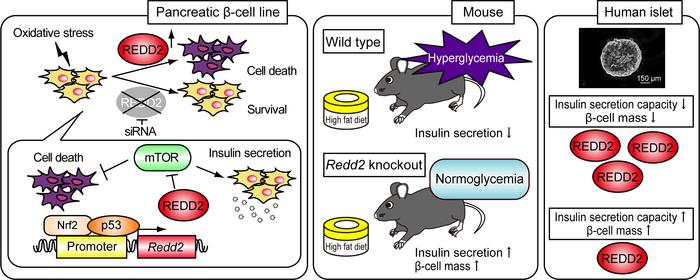In a groundbreaking study that sheds new light on the molecular underpinnings of type 2 diabetes, researchers at Osaka Metropolitan University have identified a critical gene that exacerbates pancreatic β-cell dysfunction under metabolic stress. These β-cells, which play a pivotal role in insulin production and glucose regulation, are particularly susceptible to damage triggered by prolonged oxidative stress, often stemming from unhealthy dietary habits. This discovery opens promising avenues for early diagnostic markers and therapeutic interventions to combat the worsening global epidemic of type 2 diabetes.
The research focuses on a gene known as REDD2, a stress-responsive factor whose heightened activity under conditions of metabolic stress appears to critically undermine the functional integrity of pancreatic β-cells. Under normal circumstances, stress-responsive genes like REDD2 assist cells in coping with environmental or metabolic challenges. However, this study reveals that in the context of persistent oxidative stress associated with high glucose and lipid concentrations, REDD2’s increased expression paradoxically leads to cellular dysfunction and death.
Oxidative stress, a condition characterized by the excessive accumulation of reactive oxygen species, creates a hostile intracellular environment that can trigger a cascade of deleterious effects. In pancreatic β-cells, which are already metabolically active due to their role in insulin synthesis, this stress can accelerate functional decline. The team led by Associate Professor Naoki Harada demonstrated that upon exposure to elevated glucose, fatty acids, or streptozotocin (STZ), a chemical frequently employed to induce diabetes in experimental models, REDD2 transcription is markedly upregulated.
The consequences of this upregulation are profound. REDD2 suppresses the mammalian target of rapamycin complex 1 (mTORC1) signaling pathway—a fundamental regulator of cell growth, proliferation, and survival. Inhibition of mTORC1 signaling compromises β-cell viability and insulin secretory capacity. In experimental models, overexpression of REDD2 correlated with increased β-cell apoptosis, diminished insulin production, and impaired glucose tolerance, hallmark features of the pathophysiology observed in type 2 diabetes.
Conversely, the suppression or genetic knockdown of REDD2 emerged as a protective approach. When REDD2 expression was experimentally inhibited, β-cells exhibited enhanced survival and maintained their insulin secretory functions, even when subjected to the metabolic challenges associated with high-fat diets or diabetogenic agents. These observations held true not only in cultured pancreatic β-cell lines but were also affirmed in REDD2-deficient mice, which demonstrated better glycemic control and preservation of β-cell mass compared to wild-type controls.
This pivotal insight was further corroborated by analyses of human pancreatic islet cells. Data indicates a negative correlation between REDD2 levels and the functional capacity of β-cells, suggesting that REDD2’s detrimental role is conserved across species and relevant to human health. The study underscores the complex interplay between genetic, metabolic, and environmental factors that underpin the silent progression of type 2 diabetes.
Of particular importance is the role of oxidative stress as a driver of REDD2 activation. Oxidative stress arises from an imbalance between the generation of reactive oxygen species and the cell’s antioxidant defenses, often fueled by chronic overnutrition and sedentary lifestyles prevalent in modern society. By identifying REDD2 as a mediator that links oxidative signals to β-cell demise, the research illuminates a new molecular target that could be modulated to disrupt this pathological cycle.
The disruption of mTORC1 signaling by REDD2 is a critical mechanistic cornerstone elucidated in this work. mTORC1 coordinates cellular energy status with anabolic processes, promoting protein synthesis and cell growth. Its suppression in β-cells leads to lethal consequences, as these cells require robust mTORC1 activity to meet the metabolic demands associated with insulin production. REDD2 overactivation thus impairs this vital signaling axis, precipitating cellular dysfunction.
Looking forward, these findings position REDD2 as a potent biomarker for early detection of β-cell stress preceding overt diabetes. Monitoring REDD2 expression or activity could enable clinicians to identify individuals at heightened risk for β-cell failure due to lifestyle-induced metabolic insults. Moreover, therapeutic strategies aimed at modulating REDD2, whether through small molecule inhibitors, genetic approaches, or even functional dietary components, hold potential to ameliorate β-cell damage and delay or prevent diabetes onset.
The implications of this research extend to the broader understanding of how lifestyle factors translate into molecular damage within critical endocrine cells. Efforts to develop REDD2-targeted interventions resonate deeply with public health imperatives, given the increasing prevalence of type 2 diabetes worldwide and the limitations of current treatments that often address symptoms rather than root causes.
In conclusion, the identification of REDD2’s deleterious role in pancreatic β-cell biology constitutes a major advance in diabetes research. By revealing the molecular cascade linking metabolic stress to cellular dysfunction, Osaka Metropolitan University’s team places a new molecular regulator at the forefront of potential diagnostic and therapeutic exploration. As such, REDD2 emerges not only as a biomarker of β-cell vulnerability but also as a compelling target to preserve pancreatic function in the face of metabolic challenges.
Subject of Research: Animals
Article Title: Nrf2- and p53-inducible REDD2/DDiT4L/Rtp801L confers pancreatic β-cell dysfunction, leading to glucose intolerance in high-fat diet-fed mice
News Publication Date: 21-May-2025
Web References: http://dx.doi.org/10.1016/j.jbc.2025.110271
Image Credits: Osaka Metropolitan University
Keywords: REDD2, pancreatic β-cells, oxidative stress, insulin secretion, mTORC1 pathway, type 2 diabetes, metabolic stress, glucose intolerance, β-cell apoptosis, therapeutic targets




